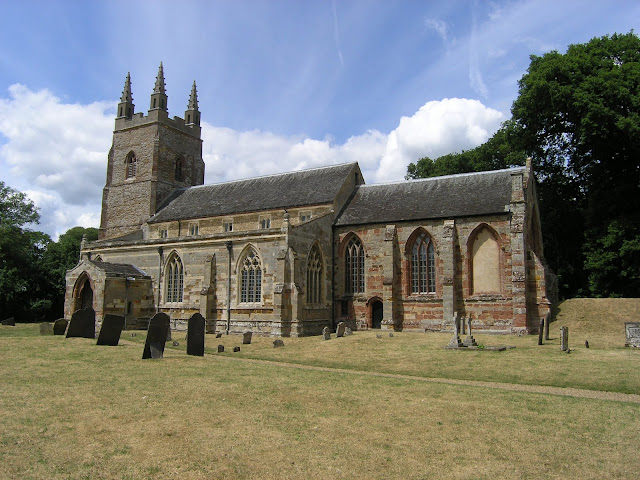This church has long been on my list to visit, but until recently I had not realised that I had driven by it on countless occasions when using the A14. I vowed next time I came this way I would stop here. I first drove by the big house, Stanford Hall, which, in its parkland setting. is actually in Leicestershire, separated by a river and a county boundary from its parish church. It is a large church, all of c1300-50 according to the Master. The chancel and the south aisle appear to be the earliest part with intersecting tracery, although the east end of the aisle sees a move to reticulation which is used throughout the north aisle. Some windows are blocked, suggesting large later monuments inside. Plain parapet to the aisle, none to the nave and chancel. Some later alterations include the ball finials to the corners of the aisle, the odd blocky pinnacles at the east end, and the rather crude but effective parapet and pinnacles on the tower which look C18.
 I walked the path towards the porch with its cusped outer entrance to find the church door open wide. Immediately the eye is drawn in all directions by the fantastic array of monuments and the show of medieval stained glass. The church was devoid of furniture, which here added to the appreciation of the architecture and fittings, except at the east end of the aisle where the chairs were stacked and covered with tarpaulins to protect them from the ever growing curse protected by law that exists in an increasing number of English churches, namely bats. Everything was covered in droppings and a notice in the porch says that the church apologises for the state of the interior and is working hard with English Heritage and English Nature to try to improve matters, although I am not sure how given the legal protection these vermin with wings enjoy. I can but give you a flavour of this church and all its wonders in seven pictures and a few more words. I took 77 pictures and most of these in time will be added to my flickr photo stream. Apart from the vast surviving collection of stained glass (C14-C16) and the fifteen major monuments inside the church (mainly to members of the Cave family of the Hall, C14-1896) there is another major treasure here. It is the C16 organ standing on the west gallery which is said to have come here from the Royal Chapel in Whitehall.
I walked the path towards the porch with its cusped outer entrance to find the church door open wide. Immediately the eye is drawn in all directions by the fantastic array of monuments and the show of medieval stained glass. The church was devoid of furniture, which here added to the appreciation of the architecture and fittings, except at the east end of the aisle where the chairs were stacked and covered with tarpaulins to protect them from the ever growing curse protected by law that exists in an increasing number of English churches, namely bats. Everything was covered in droppings and a notice in the porch says that the church apologises for the state of the interior and is working hard with English Heritage and English Nature to try to improve matters, although I am not sure how given the legal protection these vermin with wings enjoy. I can but give you a flavour of this church and all its wonders in seven pictures and a few more words. I took 77 pictures and most of these in time will be added to my flickr photo stream. Apart from the vast surviving collection of stained glass (C14-C16) and the fifteen major monuments inside the church (mainly to members of the Cave family of the Hall, C14-1896) there is another major treasure here. It is the C16 organ standing on the west gallery which is said to have come here from the Royal Chapel in Whitehall. I could write about this outstanding church for many more paragraphs, but that does not mean I will convey to the reader more than at catalogue of names, sculptors and windows which Pevsner or the official listing do already. What I will say in conclusion is to come here if you can, you will not be disappointed, unless of course you find the church locked.










No comments:
Post a Comment